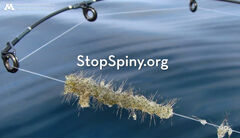 Stop the Spread of Spiny Waterfleas Spiny waterfleas are small aquatic predators native to Eurasia. The first report of spiny waterfleas in North America was in Lake Ontario in 1982 and was introduced to the Great Lakes in ballast water from ocean-going ships. “Spiny” is a species of zooplankton – small animals that rely on water currents and wind to move long distances. They prefer large, deep, clear lakes, but can also be found in shallower waters. This tiny invasive zooplankton has a major appetite, which can cause big problems in the food web, particularly for young fish and native fish. It can cause big problems for anglers, recreationalists and aquatic ecosystems. We can all help stop the spread, but first, it’s important to learn how to identify the spiny waterflea (see the photo and details here) and know ahead of time how to prevent accidentally spreading them from lake to lake.After being on the lake and when well away from the water, start by draining all water from your boat and gear, including the bilge, livewell, and bait buckets. After draining, use a dry dishcloth or towel to:
Stop the Spread of Spiny Waterfleas Spiny waterfleas are small aquatic predators native to Eurasia. The first report of spiny waterfleas in North America was in Lake Ontario in 1982 and was introduced to the Great Lakes in ballast water from ocean-going ships. “Spiny” is a species of zooplankton – small animals that rely on water currents and wind to move long distances. They prefer large, deep, clear lakes, but can also be found in shallower waters. This tiny invasive zooplankton has a major appetite, which can cause big problems in the food web, particularly for young fish and native fish. It can cause big problems for anglers, recreationalists and aquatic ecosystems. We can all help stop the spread, but first, it’s important to learn how to identify the spiny waterflea (see the photo and details here) and know ahead of time how to prevent accidentally spreading them from lake to lake.After being on the lake and when well away from the water, start by draining all water from your boat and gear, including the bilge, livewell, and bait buckets. After draining, use a dry dishcloth or towel to:
- Wipe fishing lines and reels
- Wipe drained livewells
- Wipe drained bait buckets
If you’ve seen an invasive waterflea or other invasive species in the wild in, please contact:
Ontario: www.EDDMapS.org/Ontario or call 1-800-563-7711
Manitoba: www.Manitoba.ca/StopAIS or call 1-87-STOP AIS-0
Minnesota: www.EDDMapS.org or call 1-218-616-8102
To learn more about how recreational angling gear can contribute to the spread of spiny water flea, visit the Minnesota Aquatic Invasive Species Research Centre’s research project page.
